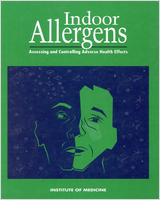NCBI Bookshelf. A service of the National Library of Medicine, National Institutes of Health.
More than 50 million Americans, one out of five, suffer from hay fever, asthma, and other allergic diseases. Many of these conditions are caused by exposure to allergens in indoor environments such as the house, work, and school--where we spend as much as 98 percent of our time.
Developed by medical, public health, and engineering professionals working together, this unique volume summarizes what is known about indoor allergens, how they affect human health, the magnitude of their effect on various populations, and how they can be controlled. The book addresses controversies, recommends research directions, and suggests how to assist and educate allergy patients, as well as professionals.
Indoor Allergens presents a wealth of information about common indoor allergens and their varying effects, from significant hay fever to life-threatening asthma. The volume discusses sources of allergens, from fungi and dust mites to allergenic chemicals, plants, and animals, and examines practical measures for their control.
Indoor Allergens discusses how the human airway and immune system respond to inhaled allergens and assesses patient testing methods, covering the importance of the patient's medical history and outlining procedures and approaches to interpretation for skin tests, in vitro diagnostic tests, and tests of patients' pulmonary function.
This comprehensive and practical volume will be important to allergists and other health care providers; public health professionals; specialists in building design, construction, and maintenance; faculty and students in public health; and interested allergy patients.
Contents
- Committee On The Health Effects Of Indoor Allergens
- Preface
- Acknowledgments
- Executive Summary
- 1. Introduction
- 2. Magnitude and Dimensions of Sensitization and Disease Caused by Indoor Allergens
- 3. Agents, Sources, Source Controls, and Diseases
- 4. Mechanisms of Immune Function
- 5. Medical Testing Methods
- 6. Assessing Exposure and Risk
- 7. Engineering Control Strategies
- 8. The Role of Education
- References
- Acronyms
- Glossary
- Committee and Staff Biographies
This project was supported by funds from the Environmental Protection Agency, National Institute of Environmental Health Sciences, National Institute of Allergy and Infectious Diseases, National Heart, Lung, and Blood Institute, and Agency for Toxic Substances and Disease Registry.
NOTICE: The project that is the subject of this report was approved by the Governing Board of the National Research Council, whose members are drawn from the councils of the National Academy of Sciences, the National Academy of Engineering, and the Institute of Medicine. The members of the committee responsible for the report were chosen for their special competencies and with regard for appropriate balance.
This report has been reviewed by a group other than the authors according to procedures approved by a Report Review Committee consisting of members of the National Academy of Sciences, the National Academy of Engineering, and the Institute of Medicine.
The Institute of Medicine was chartered in 1970 by the National Academy of Sciences to enlist distinguished members of the appropriate professions in the examination of policy matters pertaining to the health of the public. In this, the Institute acts under both the Academy's 1863 congressional charter responsibility to be an adviser to the federal government and its own initiative in identifying issues of medical care, research, and education.
- NLM CatalogRelated NLM Catalog Entries
- The pattern of indoor and outdoor respiratory allergens in asthmatic adult patients in a humid and desert newly developed country.[Eur Ann Allergy Clin Immunol. ...]The pattern of indoor and outdoor respiratory allergens in asthmatic adult patients in a humid and desert newly developed country.Sattar HA, Mobayed H, al-Mohammed AA, Ibrahim AS, Jufairi AA, Balamurugan P, Mary VP, Bener A. Eur Ann Allergy Clin Immunol. 2003 Oct; 35(8):300-5.
- House dust mite and cockroach exposure are strong risk factors for positive allergy skin test responses in the Childhood Asthma Management Program.[J Allergy Clin Immunol. 2001]House dust mite and cockroach exposure are strong risk factors for positive allergy skin test responses in the Childhood Asthma Management Program.Huss K, Adkinson NF Jr, Eggleston PA, Dawson C, Van Natta ML, Hamilton RG. J Allergy Clin Immunol. 2001 Jan; 107(1):48-54.
- Review Allergy to house dust mites and asthma.[P R Health Sci J. 2004]Review Allergy to house dust mites and asthma.Milián E, Díaz AM. P R Health Sci J. 2004 Mar; 23(1):47-57.
- [Farmers' children suffer less from hay fever and asthma].[Dtsch Med Wochenschr. 2000][Farmers' children suffer less from hay fever and asthma].Gassner-Bachmann M, Wüthrich B. Dtsch Med Wochenschr. 2000 Aug 4; 125(31-32):924-31.
- Review Influence of indoor factors in dwellings on the development of childhood asthma.[Int J Hyg Environ Health. 2011]Review Influence of indoor factors in dwellings on the development of childhood asthma.Heinrich J. Int J Hyg Environ Health. 2011 Jan; 214(1):1-25. Epub 2010 Sep 18.
- Indoor AllergensIndoor Allergens
- ATP6V0E1 ATPase H+ transporting V0 subunit e1 [Homo sapiens]ATP6V0E1 ATPase H+ transporting V0 subunit e1 [Homo sapiens]Gene ID:8992Gene
- Gene Links for GEO Profiles (Select 122128421) (1)Gene
Your browsing activity is empty.
Activity recording is turned off.
See more...
